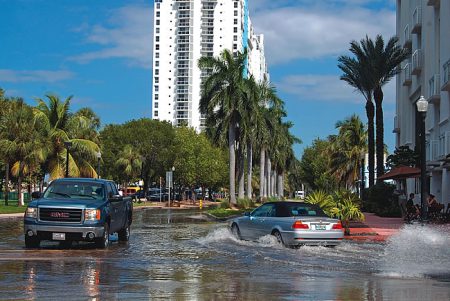August 10, 2017 – A new research paper from the University of Florida published this week calculated sea level rise from south of Cape Hatteras to the Florida coast using data from 2011 to 2015. What they found surprised them. It turns out that the sunny-day flooding in places like Miami and Miami Beach were happening more frequently at high tide because sea levels were changing at an unprecedented rate.
The paper which appears in the scientific journal, Geophysical Research Letters, is entitled, “Spatial and temporal variability of sea-level rise hotspots over the eastern United States.” It states that tide-gauge records in the coastal areas from south of Cape Hatteras to Florida, in the period between 2011 and 2015 show sea level rises three times faster than the global average.
So what did they determine was the cause? Was it global warming? Or was it something else?
In the draft report prepared by 13 government agencies and departments on climate change, that appeared in the New York Times this week, the authors described the various ocean circulation phenomenon such as the North Atlantic Oscillation and El Nino and their influence on weather and climate. And lo and behold the above-named paper linked the observed data with these two large atmospheric phenomena and their intersection as the primary explanation for triple the rate in sea level rise.
It should be understood that sea level is not the same everywhere on the planet. The gravity exerted by the Moon raises ocean levels at one part of the planet and causes their opposite fall on other parts of the planet. Ocean thermal expansion from carbon dioxide absorption further raises sea levels. Storms like hurricanes cause surges. Melting land ice (not sea ice) raises ocean levels. Fast surface currents can influence sea levels on land facing the outward edge of the flow. It was this latter condition that was first thought to be the cause of the sudden sea level rise on the U.S. East Coast.
But it turns out, according to this paper, that the 1.9 centimeters (0.75 inches) rise off the Southeast Atlantic coastline is a result of the collision between El Nino induced weather systems and the North Atlantic Oscillation. The convergence of these two, the paper states, caused winds to blow towards the American coast, and not away. The end result, water piled up along the American Eastern Seaboard from the Mid-Atlantic States to Florida. If the researchers are right, the decline of the El Nino should mean the rises in ocean sea levels will resume a more normal pattern.
That doesn’t take places like Tybee Island in the Chesapeake Bay (the island whose mayor was reassured by President Trump that it would not disappear), Charleston, South Carolina, and Miami-Miami Beach off the endangered list for sunny-day floods. But it may decrease the frequency.
The researchers, in their conclusions, state that global sea levels will continue to climb and that storm surges when superimposed will mean higher mean ocean levels. And when these weather phenomena converge it will mean an increased frequency in “nuisance flooding.” When you consider the density of population along this particular coastline, “the risk factors for coastal vulnerability” will continue to escalate.
Is there another El Nino and North Atlantic Oscillation in the Near Future? In its most recent climate prediction evaluation, the National Oceanic and Atmospheric Administration rates the chances of an El Nino occurrence this year at 15 to 20%. If and when it does happen it will start near year end with a detected warming of the Pacific Ocean off Peru. And as for the North Atlantic Oscillation, its reoccurrence as a weather factor will be predicted by the tracking of the Jet Stream. If the Stream levels out rather than follows the current circuitous meandering pattern of the last few years (the cause for polar vortices in Eastern North America the last two winters), we may see the Southeastern United States coastline once more under siege by an abrupt rise in sea levels and consequently more frequent salt water flooding of coastal communities.









